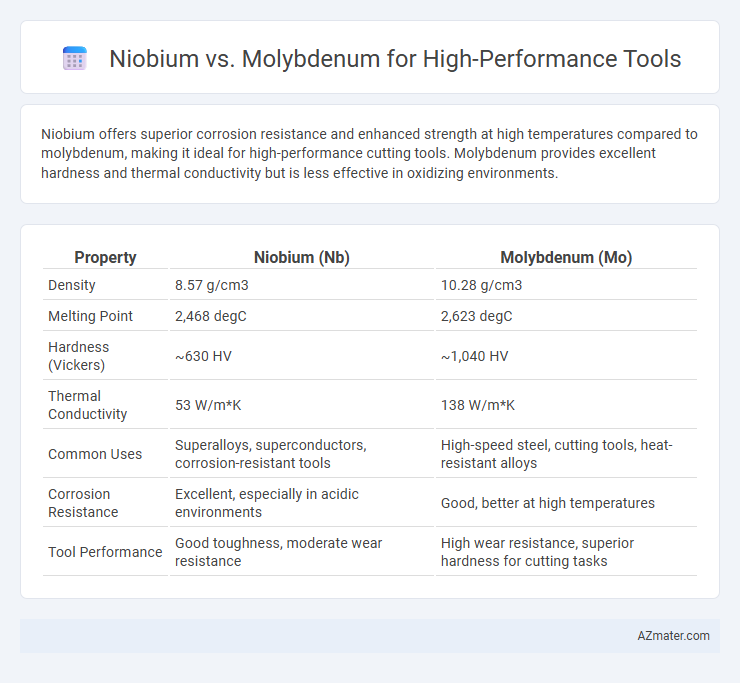Niobium offers superior corrosion resistance and enhanced strength at high temperatures compared to molybdenum, making it ideal for high-performance cutting tools. Molybdenum provides excellent hardness and thermal conductivity but is less effective in oxidizing environments.
Table of Comparison
| Property | Niobium (Nb) | Molybdenum (Mo) |
|---|---|---|
| Density | 8.57 g/cm3 | 10.28 g/cm3 |
| Melting Point | 2,468 degC | 2,623 degC |
| Hardness (Vickers) | ~630 HV | ~1,040 HV |
| Thermal Conductivity | 53 W/m*K | 138 W/m*K |
| Common Uses | Superalloys, superconductors, corrosion-resistant tools | High-speed steel, cutting tools, heat-resistant alloys |
| Corrosion Resistance | Excellent, especially in acidic environments | Good, better at high temperatures |
| Tool Performance | Good toughness, moderate wear resistance | High wear resistance, superior hardness for cutting tasks |
Introduction to High-Performance Tool Materials
Niobium and molybdenum are critical high-performance tool materials valued for their exceptional strength, heat resistance, and wear durability. Niobium enhances toughness and corrosion resistance in cutting tools, while molybdenum provides superior hardness and thermal stability under extreme machining conditions. Both metals are extensively used in aerospace and automotive industries to improve tool lifespan and operational efficiency.
Overview of Niobium and Its Key Properties
Niobium is a transition metal known for its excellent corrosion resistance, high melting point of 2,468degC, and superior strength at elevated temperatures, making it ideal for high-performance tools. Its low density (8.57 g/cm3) and good ductility enable enhanced tool durability and wear resistance compared to molybdenum. Niobium's ability to form stable carbides improves hardness and thermal stability, essential for cutting and forming applications demanding extreme performance.
Molybdenum: Characteristics and Industrial Applications
Molybdenum exhibits exceptional high-temperature strength, corrosion resistance, and thermal conductivity, making it ideal for high-performance tools subjected to extreme conditions. Its role in industrial applications includes use in cutting tools, aerospace components, and catalytic converters due to its durability and stability under stress. Compared to niobium, molybdenum provides superior hardness and wear resistance, essential for tools requiring prolonged operational life and precision.
Mechanical Strength: Niobium vs. Molybdenum
Niobium exhibits superior mechanical strength at elevated temperatures compared to molybdenum, making it ideal for high-performance tools requiring durability under extreme conditions. Its ability to maintain structural integrity and resist deformation surpasses molybdenum, which, while strong, tends to soften at high heat. Niobium's exceptional strength-to-weight ratio also enhances tool longevity and performance in demanding industrial applications.
Heat Resistance and Thermal Stability Comparison
Niobium exhibits superior heat resistance compared to molybdenum, maintaining structural integrity at temperatures exceeding 2,000degC, making it ideal for high-performance tools exposed to extreme heat. Molybdenum offers excellent thermal stability up to approximately 1,600degC but tends to oxidize rapidly beyond this threshold, reducing its effectiveness in prolonged high-temperature applications. The enhanced oxidation resistance and strength retention of niobium under thermal stress provide a significant advantage over molybdenum for tools requiring exceptional durability in harsh, high-heat environments.
Corrosion Resistance: Which Metal Performs Better?
Niobium exhibits superior corrosion resistance compared to molybdenum, especially in aggressive environments such as acidic and chloride-rich conditions often encountered in high-performance tooling applications. Its ability to form a stable, protective oxide layer enhances durability and reduces susceptibility to pitting and crevice corrosion. While molybdenum offers good corrosion resistance, niobium outperforms it in scenarios requiring long-term material stability against oxidative and chemical degradation.
Workability and Fabrication Considerations
Niobium offers superior workability compared to molybdenum due to its ductility and lower melting point, enabling easier forming and machining in high-performance tool applications. Molybdenum's higher melting point and greater hardness provide enhanced wear resistance but require specialized fabrication techniques such as vacuum melting and controlled atmosphere processing to avoid brittleness and cracking. Balancing fabrication considerations, niobium is preferred for complex shapes and precise tolerances, while molybdenum suits environments demanding extreme heat resistance and structural stability.
Cost Efficiency and Market Availability
Niobium offers superior cost efficiency for high-performance tools due to its lower market price compared to molybdenum, while delivering comparable strength and corrosion resistance. Molybdenum, although more expensive, provides exceptional wear resistance and thermal stability, making it ideal for extreme operating conditions. Market availability favors molybdenum with broader global supply chains, whereas niobium's limited sources can impact procurement for large-scale manufacturing.
Environmental Impact and Sustainability
Niobium and molybdenum both offer valuable properties for high-performance tools, but niobium stands out for its lower environmental footprint due to more energy-efficient extraction and refining processes. Molybdenum mining generates higher levels of sulfur dioxide and heavy metal contaminants, increasing ecological risks and requiring stricter remediation measures. Sustainable tool manufacturing increasingly favors niobium alloys for extended tool lifespan and reduced resource consumption, aligning with circular economy principles.
Choosing the Right Metal for High-Performance Tools
Niobium offers exceptional strength, corrosion resistance, and thermal stability, making it ideal for high-performance tools requiring durability under extreme conditions. Molybdenum provides superior hardness, high melting point, and excellent wear resistance, suitable for cutting and drilling operations demanding precision and toughness. Selecting between niobium and molybdenum depends on the specific tool application, temperature exposure, and desired balance between hardness and corrosion resistance.

Infographic: Niobium vs Molybdenum for High-performance Tool
 azmater.com
azmater.com